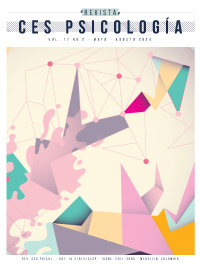Apego parental y uso problemático de internet en jóvenes: efecto moderador de la regulación emocional
DOI:
https://doi.org/10.21615/cesp.7142Palabras clave:
apego a los padres, regulación emocional, internet, adolescentes y jóvenes adultosResumen
Según la teoría del apego, los individuos manifiestan una necesidad intrínseca de establecer vínculos afectivos con sus cuidadores primarios. El apego seguro a los padres y la gestión de la regulación emocional parecen ser factores protectores contra el uso problemático de Internet. Este estudio tuvo como objetivo analizar el efecto del apego a los padres en el desarrollo del uso problemático de Internet en adolescentes y jóvenes adultos, y comprobar el papel moderador de la regulación emocional en esta asociación. Se trata de una investigación empírica transversal con una muestra aleatoria. La muestra se compuso por 936 estudiantes de ambos sexos, con edades comprendidas entre los 14 y los 20 años. Los datos fueron recogidos presencialmente a través de The Father and Mother Attachment Questionnaire (QVPM, Matos & Costa, 2001), Emotional Regulation Difficulties Scale (DERS Gratz & Roemer, 2004; adapted by Coutinho et al., 2010), y Generalized Problematic Internet Use Scale 2 (GPIUS-2, Caplan, 2010; adapted by Pontes et al., 2016). Los resultados sugieren que la inhibición de la exploración y la individualidad en el apego a las figuras parentales tienen un efecto predictivo sobre el uso problemático de Internet, y que los impulsos, como dimensión de la dificultad de regulación emocional, tienen un efecto moderador de esta asociación. Así, se entiende que la frecuencia de uso excesivo de internet, específicamente de las redes sociales, así como la falta de supervisión parental en el uso de internet por parte de sus hijos, puede estar asociado con conductas de Uso Problemático de Internet en adolescentes y jóvenes. adultos.
Descargas
Referencias bibliográficas
Ainsworth, M. (1969). Object relations, dependency, and attachment: theoretical review of the infant-mother relationship. Child Development, 40, 969-1026.
Akin, A. (2012). The relationships between Internet addiction, subjective vitality, and subjective happiness. Cyberpsychology, Behavior, and Social Networking, 15(8), 404-410. https://doi.org/10.1089/cyber.2011.0609
Arnett, J. (2007). Emerging adulthood: What is it, and what is it good for? Child Development Perspectives, 1, 68-73. https://doi.org/10.1111/j.1750-8606.2007.00016.x
Assunção, R. (2016). Facebook: novas formas de comunicação e adaptação psicossocial de adolescentes. (tese de doutoramento não publicada). Universidade do Porto- Faculdade de Psicologia e de Ciências da Educação, Porto.
Assunção, R., Costa, P., Tagliabue, S., & Matos, P. M. (2017). Problematic facebook use in adolescents: associations with parental attachment and alienation to peers. Journal of Child and Family Studies, 26(11), 2990-2998. https://doi.org/10.1007/s10826-017-0817-2.
Baumgartner, S., Valkenburg, P., & Peter, J. (2010). Assessing causality in the relationship between adolescents’ risky sexual online behavior and their perceptions of this behavior. Journal of Youth and Adolescence, 39, 1226–1239. https://doi.org/10.1007/s10964-010-9512-y.
Boniel-Nissim, M., & Sasson, H. (2018). Bullying victimization and poor relationships with parents as risk factors of problematic Internet use in adolescence. Computers in Human Behavior, 176-183. https://doi.org/10.1016/j.chb.2018.05.041
Bowlby, J. (1973). Attachment and loss. Vol.2: Separation, anxiety and anger. Basic Books.
Bowlby, J. (1988). A secure base: parent-child attachment and healthy human development. Basic Books.
Burén-J., & Lunde, C. (2018). Sexting among adolescents: a nuanced and gendered online challenge for young people. Computers in Human Behavior, 85, 210-217. https://doi.org/10.1016/j.chb.2018.01.003
Caplan, S. E. (2010). Theory and measurement of generalized problematic internet use: A two-step approach. Computers in Human Behavior, 26, 1089-1097. https://doi.org/10.1016/j.chb.2010.03.012
Correia, F., & Mota, C. P. (2016). Ambiente familiar e qualidade da vinculação amorosa: papel mediador da individuação em jovens adultos. Análise Psicológica, 34(1), 15-29. https://doi.org/10.14417/ap.1018
Coutinho, J., Ribeiro, E., Ferreirinha, R., & Dias, P. (2010). Versão portuguesa da Escala de Dificuldades de Regulação Emocional e sua relação com sintomas psicopatológicos. Revista de Psiquiatria Clínica, 37(4), 145-151.
Davis, R. A. (2001). A cognitive-behavioral model of pathological internet use. Computers in Human Behavior, 17(2), 187-195. https://doi.org/10.1016/S0747-5632(00)00041-8
Davis, R. A., Flett, G. L., & Besser, A. (2002). Validation of a new scale for measuring problematic internet use: implications for pre-employment screening. CyberPsychology & Behavior, 5(4), 331-345. https://doi.org/10.1089/109493102760275581
Del Giudice, M. (2019). Sex differences in attachment styles. Current opinion in psychology, 25, 1-5. https://doi.org/10.1016/j.copsyc.2018.02.004
Erikson, E. (1968). Identity: Youth and crisis. Norton.
Faria, H. C., Costa, I. P., & Neto, A. S. (2018). Hábitos de utilização das novas tecnologias em crianças e jovens. Gazeta Médica, 4 (5), 271-276.
Fleming, M. (2005). Entre o medo e o desejo de crescer: Psicologia da adolescência. Edições Afrontamento.
Gámez-Guadix, M., Orue, L., Smith, P., & Calvete, E. (2018). Longitudinal and reciprocal relationships of cyberbullying with depression, substance use, and problematic internet use among adolescents. Journal of Adolescent Health, 53(4), 446-452. https://doi.org/10.1016/j.jadohealth.2013.03.030
Gardener, E. K. T., Carr, A., MacGregor, A., & Felmingham, K. (2013). Sex differences and emotion regulation: an event-related potential study. Plos One, 8(10), 1-9. https://doi.org/10.1371/journal.pone.0073475
Gratz, K. L., & Roemer, L. (2004). Multidimensional assessment of emotion regulation and dysregulation. Development, factor structure, and initial validation of the difficulties in emotion regulation scale. Journal of psychopathology and behavioral assessment, 26(1), 41-54.
Henriques, B. M. (2014). Qualidade da vinculação e comportamento antissocial na infância. International Journal of Development and Educational Psychology, 1(1), 35-43. https://doi.org/10.17060/ijodaep.2014.n1.v4.591
Ho, S. S., Lwin, M. O., & Lee, E. W. (2017). Till logout do us part? Comparison of factors predicting excessive social network sites use and addiction between Singaporean adolescents and adults. Computers in Human Behavior, 75, 632-642. https://doi.org/10.1016/j.chb.2017.06.002.
Hormes, J., Kearns, B., & Timko, C. (2014). Craving Facebook? Behavioral addiction to online social networking and its association with emotion regulation deficits. Addiction, 9, 2079-2088. https://doi.org/10.1111/add.12713
Jenkins-Guarnieri, M. A., Wright, S. L., & Hudiburgh, L. M. (2012). The relationships among attachment style, personality traits, interpersonal competency, and Facebook use. Journal of Applied Developmental Psychology, 33(6), 294-301. https://psycnet.apa.org/doi/10.1016/j.appdev.2012.08.001
Kalaitzaki, A. E., & Birtchnell, J. (2014). The impact of early parenting bonding on young adults’ Internet addiction, through the mediation effects of negative relating to others and sadness. Addictive behaviors, 39(3), 733-736. https://doi.org/10.1016/j.addbeh.2013.12.002
Karaiskos, D., Tzavellas, E., Balta, G., & Paparrigopoulos, T. (2010). P02-232-Social network addiction: a new clinical disorder? European Psychiatry, 25, 855. https://doi.org/10.1016/S0924-9338(10)70846-4
Kayes, I., & Iamnitchi, A. (2017). Privacy and security in online social networks: A survey. Online Social Networks and Media, 3, 1-21. https://doi.org/10.1016/j.osnem.2017.09.001
Kim, H., & Davis, K. (2009). Toward a comprehensive theory of problematic Internet use: evaluating the role of self-esteem, anxiety, flow, and the self-rated importance of Internet activities. Computers in Human Behavior, 25, 490-500. https://doi.org/10.1016/j.chb.2008.11.001
Livingstone, S., Haddon, L., Gorzig, A., & Ólafsson, K. (2011). Risk and safety on the internet: the perspective of European children. Full findings. EU Kids Online, LSE.
Machado, T. S., & Pardal, A. (2013). Padrões adaptativos de aprendizagem e estratégias de regulação das emoções em adolescentes. Psicologia, Educação e Cultura, 17(2), 134-150.
Matos, P. M., & Costa, M. E. (2001). Questionário de vinculação ao pai e à mãe. Manuscrito não publicado. Faculdade de Psicologia e de Ciências da Educação da Universidade do Porto.
Matos, P. M., & Costa, M. E. (2006). Vinculação aos pais e ao par romântico em adolescentes. Psicologia, 20(1), 97-126.
Mazman, S. G., & Usluel, Y. K. (2011). Gender differences in using social networks. Turkish Online Journal of Educational Technology, 10(2), 133-139.
Meier, A. M., Carr, D. R., Currier, J. M., & Neimeyer, R. A. (2013). Attachment anxiety and avoidance in coping with bereavement: Two studies. Journal of Social and Clinical Psychology, 32(3), 315-334. https://psycnet.apa.org/doi/10.1521/jscp.2013.32.3.315
Monteiro, L., Veríssimo, M., Vaughn, B. E., Santos, A. J., & Fernandes, M. (2008). Análise do fenómeno de base segura em contexto familiar: As relações criança/mãe e criança/pai. Psicologia, 22(1), 104-25.
Moura, O., & Matos, P. M. (2008).Vinculação aos pais, divórcio e conflito interparental em adolescentes. Psicologia, 22(1), 127-152.
Nunes, F., & Mota, C. P. (2017). Vinculação aos pais, competências sociais e ideação suicida em adolescentes. Arquivos Brasileiros de Psicologia, 69(3), 52-65. http://pepsic.bvsalud.org/scielo.php?script=sci_arttext&pid=S1809-52672017000300005
Oldmeadow, J. A., Quinn, S., & Kowert, R. (2013). Attachment style, social skills, and Facebook use amongst adults. Computers in Human Behavior, 29, 1142-1149. https://doi.org/10.1016/j.chb.2012.10.006
Piguet, C., Berchtold, A., Akre, C., & Suris, J-C. (2015). What keeps female problematic internet users busy online? European Journal of Pediatrics, 1-7. https://doi.org/10.1007/s00431-015-2503-y
Pontes, H. M., Caplan, S. E., & Griffiths, M. D. (2016). Psychometric validation of the generalized problematic Internet use scale 2 in a Portuguese sample. Computers in Human Behavior, 63, 823-833. https://doi.org/10.1016/j.chb.2016.06.015.
Pontes, H. M., Patrão, I. M., & Griffiths, M. D. (2014). Portuguese validation of the Internet Addiction Test: an empirical study. Journal of Behavioral Addictions, 3(2), 107-114. https://doi.org/10.1556/JBA.3.2014.2.4
Rial, A., Gómez, P., Braña, T., & Varela, J. (2014). Actitudes, percepciones y uso de Internet y las redes sociales entre los adolescentes de la comunidad gallega (España). Anales de Psicología, 30(2), 642-655. https://doi.org/10.6018/analesps.30.2.159111
Richards, R., McGee, R., Williams, S. M., Welch, D., & Hancox, R. J. (2010). Adolescent screen time and attachment to parents and peers. Archives of Pediatrics & Adolescent Medicine, 164(3), 258-262. https://doi.org/10.1001/archpediatrics.2009.280.
Rücker, J., Akre, C., Berchtold, A., & Suris, J-C. (2015). Problematic internet use is associated with substance use in young adolescents. Acta Paediatrica. https://doi.org/10.1111/apa.12971
Sariyska, R., Reuter, M., Lachmann, B., & Montag, C. (2015). Attention deficit/hyperactivity disorder is a better predictor for problematic internet use than depression: evidence from Germany. Journal of Addiction Research & Therapy, 6(209). https://doi.org/10.4172/2155-6105.1000209
Silva Mendes, L., & da Luz Vale Dias, M. (2018). Estilos educativos parentais, confiança interpessoal e vinculação aos pais, pares e par amoroso: Sua relação numa amostra de adolescentes. Journal of Child & Adolescent Psychology/Revista de Psicologia da Criança e do Adolescente, 9(2), 27-42.
Smahel, D., Brown, B. B., & Blinka, L. (2012). Associations between online friendship and Internet addiction among adolescents and emerging adults. Development Psychology, 48(2), 381-388. https://doi.org/10.1037/a0027025
Soares, I., & Dias, P. (2007). Apego y psicopatología en jóvenes y adultos: contribuiciones recientes de la investigación. International Journal of Clinical and Health Psychology, 7(1), 177-195.
Tokunaga, R. S. (2015). Perspectives on internet addiction, problematic internet use, and deficient self-regulation: contributions of communication research. In E.L. Cohen (Ed.), Communication Yearbook 30 (pp. 131-161). Routledge.
Veríssimo, M., Fernandes, C., Santos, A., Peceguina, I., Vaughn, B., & Bost, K. (2012). A relação entre a qualidade da vinculação à mãe e o desenvolvimento da competência social em crianças de idade pré-escolar. Psicologia: Reflexão e Crítica, 24(2), 292-299.
Wegmann, E., Oberst, U., Stodt, B., & Brand, M. (2017). Online-specific fear of missing out and Internet-use expectancies contribute to symptoms of Internet-communication disorder. Addictive Behaviors Reports, 5, 33-42.
Weinstein, A., Dorani, D., Elhadif, R., Bukovza, Y., & Yarmulnik, A. (2015). Internet addiction is associated with social anxiety in young adults. Annals of Clinical Psychiatry, 27(1), 2-7.
Xie, D., Lu, J., & Xie, Z. (2015). Online emotion regulation questionnaire for adolescents: development and preliminary validation. Social Behavior and Personality: an international journal, 43(6), 955-965. https://doi.org/10.2224/sbp.2015.43.6.955
Zimmermann, P. (2004). Attachment representations and characteristics of friendship relations during adolescence. Journal of Experimental Child Psychology, 88, 83-101.
Descargas
Publicado
Cómo citar
Número
Sección
Licencia
Derechos de autor 2024 Catarina Pinheiro Mota, Bianca Monteiro

Esta obra está bajo una licencia internacional Creative Commons Atribución-NoComercial-CompartirIgual 4.0.
Revista CES Psicología ISSN 2011 3080
Facultad de Psicología, Universidad CES Primera edición 2008. Última actualización Mayo 18 de 2022. Todos los derechos reservados. Hecho el depósito legal que exige la ley.
Se autoriza la reproducción total o parcial de los artículos citando la fuente y el autor. This publication may be reproduced by mentioning the source and the authors.
| Estadísticas de artículo | |
|---|---|
| Vistas de resúmenes | |
| Vistas de PDF | |
| Descargas de PDF | |
| Vistas de HTML | |
| Otras vistas | |




